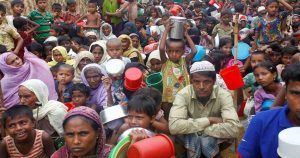
by Sahana Ghosh
A study forecasts that in the absence of interventions, groundwater contribution to Ganga river’s water flow would continue diminishing in the summer for the next 30 years.
The dwindling of Ganga river would severely affect water available for surface water irrigation, with a potential future decline in food production. This decline in river flow also has implications for achieving the UN Sustainable Development Goals by 2030. Experts, not associated with the study, also pointed to the combined blow of surface and groundwater misuse has beleaguered the Ganga river basin. Agricultural inefficiency is a chink in the chain, they say when it comes to sustainable water use.
Millions of people residing in the lower reaches of the Ganga basin in India may face food shortage in the next three decades, if the iconic river continues to lose water due to factors including unsustainable groundwater extraction, a study has claimed.
Researchers associated with the study added that low river flows could also have implications for achieving United Nations’ Sustainable Development Goals (SDGs) targets.
But experts, not associated with the study, also pointed to the combined blow of surface and groundwater misuse that has beleaguered the Ganga river basin, sheltering around 10 percent of the global population. Agricultural inefficiency is a chink in the chain, they say when it comes to sustainable water use.
The modelling

study forecasts that in the absence of interventions, groundwater contribution to the river’s water flow would continue diminishing in the summer for the next 30 years.
The analysis was conducted by Abhijit Mukherjee at the Indian Institute of Technology-Kharagpur, Soumendra Nath Bhanja (formerly at IIT Kharagpur) and Yoshihide Wada from IIASA Austria, on the stretch of the river from Varanasi to the Bay of Bengal.
“The impacts of groundwater depletion on Ganga river flows are very complex. However, our study found that there is significant concern that ongoing groundwater pumping over the basin is unsustainable, leading to not only lowering groundwater levels but also a reduction in river flows during summertime,” study co-author Wada told Mongabay-India.
This problem is more serious downstream of the Ganga river, Wada said.
Mukherjee, a lead author of the study, said: “So far, in the last three decades we have seen the groundwater input to the river decline by 50 percent during summer. This decline could go up to 75 percent compared to the scenario in the 1970s in the summer months.”
Although the modelling study doesn’t factor in climate change impacts, the authors argue that if they were to do so, the situation could be worse than that is predicted.
Rivers Bhagirathi and Alaknanda originate in Garhwal Himalayas and join at Devprayag to form the Ganga that traverses through Uttarakhand, Uttar Pradesh, Bihar, Jharkhand and West Bengal and thereafter enters Bangladesh.
Ganga’s 2525 km watercourse is sustained by rainfall in the hinterlands of the Ganga basin, Himalayan glacial melt as also groundwater discharge. In summer (non-monsoon months), this groundwater contribution (baseflow) to the river can be 30 percent in some sections and can even swell up to 60 to 70 percent, informed Mukherjee.
“The combination of groundwater (around 70 percent) and river water (30 percent) availability actually runs the farming system that yields the food crops,” Mukherjee said.
The researchers assess that at present, surface water irrigation for cropping accounts for 27 percent of the total irrigation in the study area.
Hence, the dwindling of the Ganga would also severely affect water available for surface water irrigation, with a potential decline in food production in the future.
“Our prediction shows that about 115 million people can be impacted due to insufficient food availability in the next few decades. In a status-quo scenario, this reduction would enhance in the future and there is a possibility that there would be a reverse flow of the river water to groundwater. This is called streamflow capture,” Mukherjee said.
Waste of surface water and groundwater a ‘tragedy’
Upmanu Lall, Director of the Columbia Water Center at Columbia University, who was not associated with the study, described the waste of surface and groundwater as the real “tragedy.”
“The irrigation water is not translating into the kind of yield gains we see in other states, due to a lack of agricultural extension and institution of better practices. The crop yields are actually quite low and less than 50 percent of the yields for rice and wheat in the top producing Indian states,” said Lall.
In effect, if large quantities of water are being withdrawn and this does not translate into the expected doubling of crop yield then the tragedy is that water is really being wasted.
“It is quite possible that upstream diversions contribute significantly to reduced groundwater recharge during the monsoon and hence to groundwater depletion and to base flow reduction outside the monsoon season,” he said.
A.K. Gosain of the Department of Civil Engineering, the Indian Institute of Technology-Delhi, reiterated that “unabated long-term groundwater extraction within the Ganga river basin has induced a sharp decrease in critical dry weather base-flow contributions.”
“Despite the fact that a lot of recharge is taking place, the withdrawal is more than the replenishment (naturally from the precipitation). We are mining some of the groundwater and effectively the groundwater table is falling through the years,” Gosain told Mongabay-India.
Gosain said the major factor for this non-sustainability remains agriculture and its inefficiency.
“Right now efficiency of agriculture is 35 percent. Around 80 to 85 percent of the water is being used in this sector. Ganga has a lot of water. If you can increase the efficiency from 30 to 60 percent you have almost double the water availability,” Gosain said.
“All other factors (domestic, industrial) are minor. If we really want to do something useful for the system you have to hit this factor,” he said.
Secondly, the lack of maintenance and control of canals and free water provision leads to unreliable supply through canals and this motivates the increase in groundwater pumping for irrigation, opined Lall.
“The groundwater pumping allows access to reliable supply and coupled with solar energy (which many governments in the region are promoting) to unlimited supply (in the mind of the user). So, what is obvious is that the transition from surface to groundwater irrigation is now substantial,” Lall said.
If the yields were to double or triple in this region due to better agricultural methods, continued Lall, then the total food grain production would increase substantially.
This would reduce the pressure on the arid northwest and the south to produce the rice and wheat for the Public Distribution System (more than 60 percent from those regions) and avert the long-term groundwater disaster in that highly productive belt (relative to this region), he added.
River flow and SDGs
Apart from the ongoing reduction in summer river flows heightening vulnerability of regional food production and water supply policy, Wada observed that low river flows also influence dilution of water pollution in the Ganga river, which is one of most contaminated transboundary rivers worldwide.
This is a “huge concern” for regional water supply and sanitation, he said, adding the issue could have implications for achieving United Nations’ Sustainable Development Goals (SDGs) targets.
“South Asian countries are working towards the United Nations Sustainable Development Goals (SDGs) which aim towards improving water sanitation and reducing water scarcity, but decreasing summer river flows and increasing groundwater depletion will make only more difficult for regional policymakers to achieve the targets by 2030,” study co-author Wada elaborated.
The researchers also observed that low river flows influence the dilution of water pollution in the Ganga river, which is one of most contaminated transboundary rivers worldwide.
“The lower the river flow, the more concentrated the pollutants become, making it difficult to wash them out,” Mukherjee remarked.
Wada batted for more co-operation between India and Bangladesh in regional water resources allocation.
“Local excessive groundwater pumping over two countries is affecting the river flows of the entire basin. Regional policymakers from the two countries can cooperate for better monitoring and regulation of groundwater pumping and water use at larger,” Wada said.
He noted that it is vital to understand that both upstream and downstream regions need to share the burden of better water allocation policy. “Two countries need to work very closely to establish how to improve the situation. Water scarcity will get only worse under climate change, if the situation continues,” Wada reiterated.
Regulate the use of groundwater, sow crops as per water utilisation
Since, the Ganga is a transboundary river, the river water level and discharge data are geopolitically sensitive and mostly not available in public domain.
Notwithstanding this data unavailability, the study, “for the first time demonstrates quantitatively” the dependence of present-day summer drying of the Ganga on the groundwater depletion in the Gangetic aquifers of north India because of extensive groundwater pumping.
To arrive at the forecast, the team crunched satellite data, tapped into in-situ measurements of Ganga river water and groundwater levels and ran modelling and chemical analyses.
“Generally none of the hydrological budgeting by the various government and non-government agencies account for this baseflow and hence pretty much stays as an invisible factor. Any direct measurement or report on these groundwater inputs is difficult,” Mukherjee said.
He reasoned that as a short-term measure, groundwater abstraction should be rationed.
“Growing water-intensive crops such as paddy in rotation with crops that do not require much of water is one way of achieving this. For the long-term, in-depth studies on groundwater-Ganga interaction at each segment of the river are needed in addition to augmentation by better governance,” Mukherjee said.
Highlighting the judicious use of resources so as to strike a balance between demand and availability, Gosain advocated framing regulations on judicious groundwater use.
“This means you need to pinpoint what kind of crops you can grow, how much water you can withdraw, all those things and you have to also look at livelihoods. If you look at all those procedures, your livelihood is not affected but wastage of water is minimised,” he said.
For example, there are some areas where farmers are growing a particular crop that is a guzzler of water. But that much water is not available there so the farmer cannot keep on growing that crop and withdrawing that quantity of water.
“When the water is not available to the farmer, they start digging tube-wells and extract the groundwater. So the groundwater table is falling and it is more and more expensive to draw this water. And this is one of the reasons why the farmers avail bank loans,” Gosain explained.
“And by the time he sows, the groundwater table has already gone down, due to collective withdrawal. So the poor fellow is not able to use that water and so there is sort of a competition between farmers. That is creating a lot of problems,” he said.
In view of a surge in demand for dry season irrigation water for agriculture in the area, numerical models can be a useful tool to generate not only an understanding of the underlying groundwater system but also facilitate the development of basin-wide detailed impact scenarios as inputs for management and policy action.
“The mechanisms have to be formulated and formed and guidelines have to be made and governance has to be done in terms of water utilisation. This is very doable. All the 11 states of the basin have to brainstorm together. You can look at each state individually but they can’t do anything that hampers the interest of the states. We have the Ganga Basin Authority but we can make it more effective. There has to be political will and the society at large needs to understand this problem,” Gosain suggested.
(Ref: Mukherjee, A., Bhanja, S. N., & Wada, Y. (2018). Groundwater depletion causing reduction of baseflow triggering Ganges river summer drying. Scientific reports, 8(1), 12049.)
Source: Manga Bay, India. https://india.mongabay.com/2018/09/13/a-drying-ganga-could-stall-food-security-and-prevent-achieving-sdgs/?utm_source=Mongabay+India&utm_campaign=27b323c060-EMAIL_CAMPAIGN_2018_09_13_11_01&utm_medium=email&utm_term=0_7953c9bb60-27b323c060-27622495




